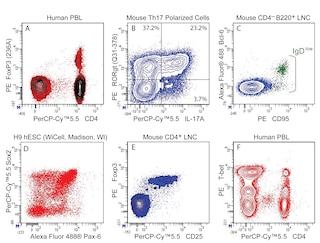Old Browser
This page has been recently translated and is available in French now.
Looks like you're visiting us from {countryName}.
Would you like to stay on the current country site or be switched to your country?




Multiparameter flow cytometric analysis of AhR expression Top Plots - AhR expression in human peripheral blood mononuclear cells. PBMCs were fixed and permeabilized with the BD Pharmingen™ Transcription Factor Buffer Set (Cat No. 562574/562725) and stained with either Alexa Fluor® 647 Mouse IgG1, κ Isotype Control (Cat. No. 557732; Left Plot) or Alexa Fluor® 647 Mouse Anti-AhR antibody (Cat. No. 565789; Right Plot) at 0.5 µg/test. Bottom Plots - AhR expression in mouse splenic leucocytes. Mouse splenic leucocytes were similarly fixed, permeabilized, stained, and analyzed. Two-parameter flow cytometric contour plots showing the correlated expression of AhR (or Ig Isotype control staining) versus side light-scatter (SSC-A) signals were derived from gated events with the forward and side light-scatter characteristics of intact leucocyte populations. Flow cytometric analysis was performed using a BD LSRFortessa™ X-20 Cell Analyzer System. Data shown on this Technical Data Sheet are not lot specific.


BD Pharmingen™ Alexa Fluor® 647 Mouse Anti-AhR

Regulatory Status Legend
Any use of products other than the permitted use without the express written authorization of Becton, Dickinson and Company is strictly prohibited.
Preparation And Storage
Product Notices
- Since applications vary, each investigator should titrate the reagent to obtain optimal results.
- An isotype control should be used at the same concentration as the antibody of interest.
- Caution: Sodium azide yields highly toxic hydrazoic acid under acidic conditions. Dilute azide compounds in running water before discarding to avoid accumulation of potentially explosive deposits in plumbing.
- The Alexa Fluor®, Pacific Blue™, and Cascade Blue® dye antibody conjugates in this product are sold under license from Molecular Probes, Inc. for research use only, excluding use in combination with microarrays, or as analyte specific reagents. The Alexa Fluor® dyes (except for Alexa Fluor® 430), Pacific Blue™ dye, and Cascade Blue® dye are covered by pending and issued patents.
- Alexa Fluor® is a registered trademark of Molecular Probes, Inc., Eugene, OR.
- Alexa Fluor® 647 fluorochrome emission is collected at the same instrument settings as for allophycocyanin (APC).
- For fluorochrome spectra and suitable instrument settings, please refer to our Multicolor Flow Cytometry web page at www.bdbiosciences.com/colors.
- Species cross-reactivity detected in product development may not have been confirmed on every format and/or application.
- Please refer to www.bdbiosciences.com/us/s/resources for technical protocols.
Companion Products






The T49-550 monoclonal antibody recognizes the human Aryl Hydrocarbon Receptor (AhR), which is also known as Aromatic Hydrocarbon Receptor, and cross-reacts with the mouse AhR. AhR is a member of basic helix-loop-helix transcription factors (Class E basic helix-loop-helix protein 76, bHLHe76). AhR can bind to a variety of endogenous and exogenous ligands including tryptophan metabolites, bacterial pigments, plant flavonoids, synthetic polycyclic aromatic hydrocarbons, or dioxin-like compounds. Upon ligand binding, cytoplasmic AhR undergoes conformational changes and translocates into the nucleus to induce gene transcription. AhR is widely expressed in mammalian tissues with the highest expression levels in the liver and lung. A number of studies suggest that AhR regulates inflammation mainly by attenuating the production of inflammatory cytokines by dendritic cells and macrophages. In addition, AhR can regulate the expansion or effector functions of Th17 cells, IL-10-secreting regulatory T (Tr1) cells, and subsets of intraepithelial lymphocytes (IEL) and innate lymphoid cells (ILC), keratinocytes, and Langerhans cells.
Development References (9)
-
Denison MS, Nagy SR. Activation of the aryl hydrocarbon receptor by structurally diverse exogenous and endogenous chemicals. Annu Rev Pharmacol Toxicol. 2003; 43(309):334. (Biology). View Reference
-
Gonzalez FJ, Fernandez-Salguero P. The aryl hydrocarbon receptor: studies using the AHR-null mice. Drug Metab Dispos. 1998; 26(12):1194-1198. (Biology). View Reference
-
Henry EC, Bemis JC, Henry O, Kende AS, Gasiewicz TA. A potential endogenous ligand for the aryl hydrocarbon receptor has potent agonist activity in vitro and in vivo. Arch Biochem Biophys. 2006; 450(1):67-77. (Biology). View Reference
-
Ho PP, Steinman L. The aryl hydrocarbon receptor: a regulator of Th17 and Treg cell development in disease. Cell Res. 2008; 18(6):605-608. (Biology). View Reference
-
Ramsay G, Cantrell D. Environmental and metabolic sensors that control T cell biology. Front Immunol. 2015; 6(1):8. (Biology). View Reference
-
Simones T, Shepherd DM. Consequences of AhR activation in steady-state dendritic cells. Toxicology. 2011; 119(2):293-307. (Biology). View Reference
-
Stockinger B, Di Meglio P, Gialitakis M, Duarte JH. The aryl hydrocarbon receptor: multitasking in the immune system. Annu Rev Immunol. 2014; 32(403):432. (Biology). View Reference
-
Veldhoen M, Hirota K, Christensen J, O'Garra A, Stockinger B. Natural agonists for aryl hydrocarbon receptor in culture medium are essential for optimal differentiation of Th17 T cells. J Exp Med. 2009; 206(1):43-49. (Biology). View Reference
-
Volchenkov R, Nygaard V, Sener Z, Skålhegg BS. Th17 Polarization under Hypoxia Results in Increased IL-10 Production in a Pathogen-Independent Manner.. Front Immunol. 2017; 8:698. (Clone-specific: Flow cytometry). View Reference
Please refer to Support Documents for Quality Certificates
Global - Refer to manufacturer's instructions for use and related User Manuals and Technical data sheets before using this products as described
Comparisons, where applicable, are made against older BD Technology, manual methods or are general performance claims. Comparisons are not made against non-BD technologies, unless otherwise noted.
For Research Use Only. Not for use in diagnostic or therapeutic procedures.
Report a Site Issue
This form is intended to help us improve our website experience. For other support, please visit our Contact Us page.